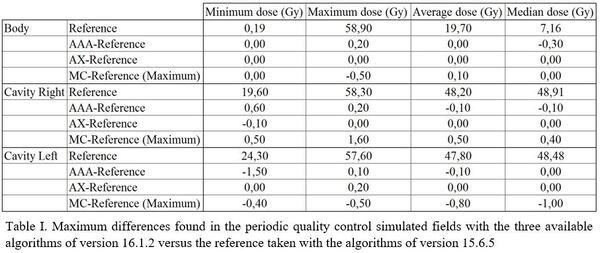Dosimetric variations due to the change of the secondary source modelling in Eclipse version 15.6.6.
Sergio Honorato Hernandez,
Spain
PO-1811
Abstract
Dosimetric variations due to the change of the secondary source modelling in Eclipse version 15.6.6.
Authors: Sergio Honorato Hernandez1, Pablo Castro Tejero1, David Hernandez Gonzalez1, Maria Roch Gonzalez1, Rocio Simon de Blas1, Pablo Chamorro Serrano1, Alexandra Elena Stoica Rosciupchin2
1H. U. La Princesa, Medical Physics, Madrid, Spain; 2H. U. La Princesa, Radiation Oncology, Madrid, Spain
Show Affiliations
Hide Affiliations
Purpose or Objective
Dose calculation algorithms allow the estimation of the absorbed dose by the patient during radiotherapy treatment. Any changes to these algorithms should be characterised before they are used in the clinical process.
The aim of this work is to show the dosimetric discrepancies observed in Anisotropic Analytical Algorithm (AAA), Acuros External Beam (AX) and Electron Monte Carlo (MC) calculation algorithms after a change in the secondary source modelling carried out in Eclipse version 15.6.6.
Material and Methods
The work has been carried out in the process of software change between Eclipse versions 15.6.5 and 16.1.2, analysing the validation tests of calculation algorithms and the periodic quality control of the TPS.
For the validation of the calculation algorithms, the simulated dose was recorded at a reference point, in irregular and asymmetric fields and fields with variations of SSD in photons and, varying the applicator and the SSD in electrons. For both photons and electrons, the procedure has been performed for all available energies. The treatments have been simulated in a Test-Box using a phantom with a CT value of -4 HU and water as the assigned material.
In the periodic quality control of TPS, the constancy of the maximum, minimum, mean and median dose obtained after the simulation of a plan of 25 fractions of 2 Gy is analysed, using a calculation of version 15.6.5 as a reference. The phantom used is the "QUASAR Multi-Purpose Body Phantom" with 2 cedar wood inserts on the sides and the field configuration consists of 2 opposite lateral static fields, performing the simulation with all available energies.
Results
In the validation of the calculation algorithms, for the plans simulated with AAA, the deviation exceeds 0.5% between the versions analysed in irregular fields, asymmetric fields and fields with SSD variation, reaching a maximum deviation of 1.7% for asymmetric fields, as shown in image I. For the simulations with AX we only obtained deviations greater than 0.5% in asymmetric fields, with a maximum deviation of 1.5%. For the simulations with MC the deviations are larger than for AAA or AX, obtaining a maximum deviation of 2.02%.

In the periodic quality control the maximum discrepancies between versions are 1.5 Gy in one of the cavities for the minimum dose with AAA, 0.2 Gy for the maximum dose with AX in the same cavity and 1.6 Gy for MC in the maximum dose in the other cavity, as shown in table I.

Conclusion
The results in the validation tests of the algorithms are within the expected range, with the largest discrepancies in the simulation of asymmetric fields, where the modelling of the secondary source becomes more important.
For the periodic quality control, the differences found for the 3 algorithms with respect to the reference are larger than those usually found before the algorithm version change.
Varian has reported that the results achieved with the new secondary source modelling are closer to reality.